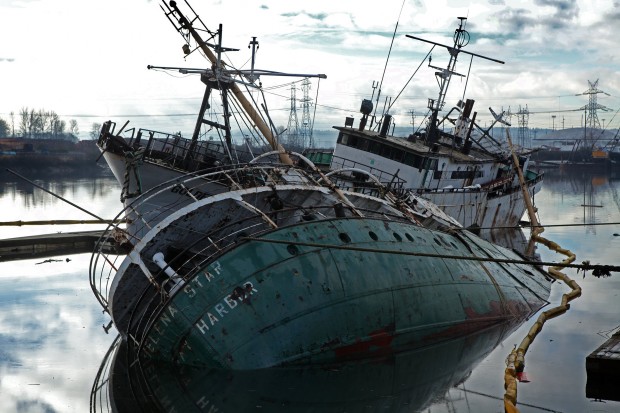The following is the text of a news release from the Washington state Department of Natural Resources:
(OLYMPIA, Wash.) (Dec. 5) — The DB General, a 700-ton crane barge, arrived on the Hylebos Waterway early this morning to prepare for lifting the 167-foot derelict vessel Helena Star today. The vessel sank at the old Mason Marine location on January 25, 2013.
Prior to the arrival of the crane barge, crews prepared the Helena Star for lifting by:
- Installing a lift pipe through holes in the bow that were cut by divers. (Using the lifting pipe—instead of strapping under the vessel—lessens the chances of disturbing sediments).
- Threading a large chain through the lift pipe to attach to the crane on the DB General.
- Installing a heavy cable to the stern of the vessel and anchoring it securely to shore to stabilize the vessel as it is lifted.
- Removing masts, antennae and other items from the vessel that could snag on the chain.
- Encircling the vessel with a “silt curtain” to control sediments in the water—or “turbidity” (Turbidity can affect light and harm aquatic habitat and fish).
- Encircling the vessel with oil containment boom.
A multi-agency unified command is coordinating the recovery effort: the U.S. Coast Guard, Washington State Department of Ecology (Ecology), Washington State Department of Natural Resources (DNR), Tacoma Fire Department, and Ballard Marine Construction.
“The removal of the derelict vessel Helena Star marks the culmination of many months of work by the U.S. Coast Guard, Ecology, DNR and other agencies, to ensure public and responder safety, limit environmental impacts, address legal issues, and implement process improvements," said Capt. Scott Ferguson, Coast Guard Sector Puget Sound commander. “We have learned a great deal from this effort, and these lessons will serve our inter-agency partnership well as we aggressively work on future derelict vessel cases.”
“Our first priority for this operation is safety for responders, the public, mariners, and nearby businesses,” said Jim Sachet, Ecology’s State On-scene Coordinator. “This vessel has been monitored since the day it sank, and precautions such as surrounding it with oil containment boom have been in place since that time. We’re taking additional precautions during the operation to raise the vessel.”
Additional precautions include:
- Spill response equipment is staged for rapid deployment to minimize potential harm to the environment.
- Addressing concerns about disturbing sediment that may have contamination from prior industrial activities. Precautions include minimizing needed sediment excavation as much as possible and surrounding the sunken vessel with a curtain to minimize spread of muddy water during the operation.
“The Helena Star is a cautionary tale,” said Commissioner of Public Lands Peter Goldmark. “People may buy an old vessel in a state of disrepair, thinking they can refurbish it or sell it for scrap and make a profit. Far too often, these dreams become nightmares when a boat sinks or goes adrift, and the citizens of our state end up footing the bill—not only for removing the vessel but for cleaning up any environmental damage it might cause.”
When the Helena Star sank in January, nearly 600 gallons of diesel and lube oil from the vessel spilled into the waterway. The Coast Guard, Ecology, and the Tacoma Fire Department acted quickly to prevent further pollution by placing oil containment boom and absorbent materials around the two vessels and using a skimmer to recover oil within the boom. The vessel has continued to sheen oil off and on since it sank, but the oil has been contained.
The U.S. Coast Guard will oversee the raising of the vessel and removal of any pollution threats. Funding for this part of the operation comes from the federal Oil Spill Liability Trust Fund. Once there is no longer a threat of an oil spill or hazardous materials release, the vessel becomes the responsibility of DNR’s Derelict Vessel Removal Program. DNR arranges for the vessel to be towed to a dry dock in Seattle where it will be hauled out, dismantled, recycled and disposed of. The funding for DNR’s portion of the operation comes from a special, one-time legislative appropriation to the program
An overall estimate of costs to raise, tow and dispose of the vessel is not yet available, as many factors are still unknown, including the condition of the vessel and what kinds of hazardous materials might be on board, such as asbestos.
Restricted area
A safety zone around the operation of 50 yards has been established to protect the public as well as the crews working on and around the vessels.
In addition, people are asked to not trespass on private property near the operation.
For a timeline and background of the sinking of the Helena Star, visit Ecology’s incident web page, www.ecy.wa.gov/programs/spills/incidents/FV.HelenaStar.GoldenWest/FV.HelenaStar&GoldenWest.html

